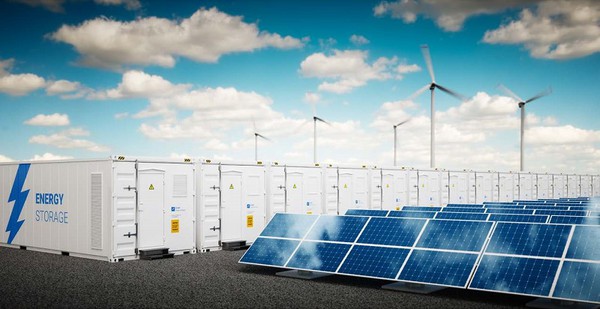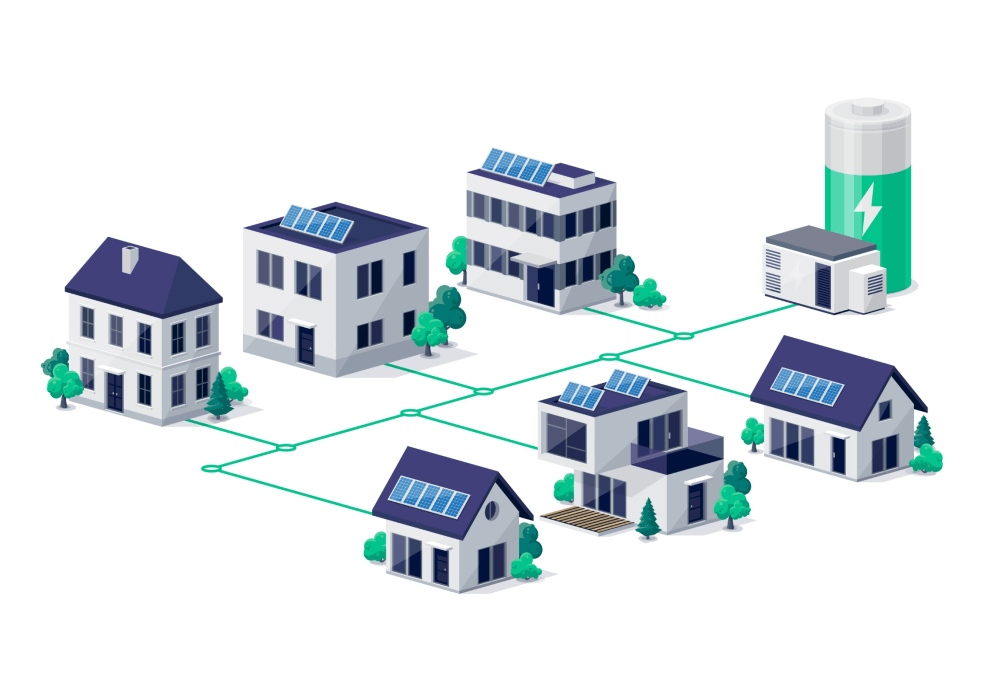Many people had the following questions concerning commercial solar battery storage:
How to maximize solar energy's cost-cutting potential by including battery storage
What financial advantages (beyond reduced energy costs) are there?
If their industry is a good fit for solar batteries
The financial implications of integrating solar energy with battery storage
This primer will provide you with the information you need to make your company more sustainable and lucrative. Since batteries come with much less warranty protection than photovoltaic (PV) panels, this solution also solves one of the main issues of storage technology: servicing and upgrading batteries.
However, before getting started, you should familiarize yourself with the fundamentals of how battery storage technology operates.

Solar batteries installed on-site can be used to store energy generated by your PV panels or purchased from the grid. Your company or the wider energy grid can receive power from this reserve once it has been discharged.
The above setup will allow business owners to significantly reduce their monthly electricity costs:
The first thing to do is incorporate on-site batteries into a preexisting PV installation or a freshly commissioned solar power system.
During the day, you run your company on solar energy collected by your panels. If there is an overflow of solar power, it is stored in batteries rather being sent back into the grid.
Rather than relying on the utility grid for power, you may run your business on the stored solar energy in your batteries during the night or on overcast days.
When both your PV panels and solar batteries are dead in the preceding scenario, only then will you need to buy grid electricity. You can still utilize the utility electricity you purchase to charge your batteries or run your company, whatever is more practical at the time.
The vast majority of battery storage options are permanently installed, typically close to the circuit breaker panel. However, the aforementioned advantages can be achieved with EVs as well. Each vehicle has built-in batteries that can charge from the sun and release energy as needed. Some companies use entire fleets of EVs to handle their energy and storage needs, but this strategy has a storage capacity limit set by the number of EVs in use.
Adding batteries to a new or preexisting solar PV system is more expensive initially. There are also more parts in the system now, which implies more work to keep it running smoothly, which drives up the price even more.
Additionally, there are currently more accessible and affordable options to "store" excess solar power. For instance, you can feed extra solar power into the grid through a net energy metering program, which is available in most states. Utilities are required to compensate you for this power, and they often do so by providing bill credits. In this setup, the entire grid serves as "virtual" battery for your daytime solar power. You need just make a nighttime purchase of grid power (when prices are typically lower). In addition, you can use your accumulated utility credits to reduce your utility expenses.
More and more businesses are switching to solar batteries despite the ease and convenience of net energy metering. The reasons for the expansion of this pattern will be discussed below.

In these cases, battery storage might act as a buffer between you and the utility grid. It's a solar power backup system you can use before going completely off the grid. This setup will save you money instantly, without any effort on your part.
However, by planning when and how to use the power stored in your commercial solar batteries, you may increase these savings. Peak shaving and load shifting are two of the most prevalent strategies.
Utility companies typically charge commercial and industrial clients more based on their peak electricity consumption during a given billing cycle. To guarantee that these high-volume electrical users can always get the power they require, this action is essential. However, this also necessitates that utilities keep resources and equipment on standby even when no one is utilizing the supplementary power.
Utilities cover these standby costs through "demand charges," the energy equivalent of Internet bandwidth. The higher your potential peak demand for electricity, the higher your base rate will be for that billing cycle. A review of past energy bills can reveal unusually high usage patterns. Those spikes indicated times of peak electricity consumption. They are also used by utilities when determining the demand fees your company will be charged.
Historically, companies have had to curtail production in order to maintain consumption levels when trying to lower these costs. However, if you have batteries, you can use that solar energy when you really need it. As a result, your demand fees will be lower than they otherwise would have been.
If your largest energy demands occur at predictable times throughout the day, you may be able to significantly reduce your monthly utility bills by employing a peak shaving approach. Think about a city's fleet of school buses, for instance, and assume that they all come back to the garage to be charged at the same time every day. If the city could use batteries to smooth out the daily peak demand, everyone's power expenditures would go down.
Through load shifting, companies can reschedule their most power-hungry processes for when electricity is cheapest (when solar power is available). They use batteries at the most expensive times of day to draw power from the grid. It is important to remember that these companies are still using the same amount of energy as before; they are simply "shifting" when they use it.
Predictable energy users, especially businesses, can benefit from peak shaving. Most solar-powered workplaces, for instance, rely on grid power once the sun goes down. Not only does this cause an unexpected increase in consumption (and therefore demand charges), but in many regions' energy markets, sunset is also the time when rates are at their highest.
However, using batteries, you may store energy from the sun to use later when the sun has set. Using this method, you may prevent sudden increases in consumption while maintaining the same level of "work."
Combining solar energy with battery storage is a money-saving option for most business owners. The benefits of this combination, however, extend far beyond merely lowering monthly energy costs. Some of the motivating factors for this trending couple are listed below.

Adding on-site batteries can make a business more robust if it operates in a region prone to regular grid outages. When the main power source fails, backup generators keep your business running.
Particularly in states like California and Texas, which have seen severe grid failures in recent years, this strategy is essential. However, as the weather becomes increasingly unpredictable due to climate change, more companies throughout the world will likely include batteries in their continuity and resilience plans.
There are times when a backup power source is needed for reasons other than maintaining operations. It is a matter of life and death to have constant access to energy. This group includes hospitals, data centers, emergency centers, and military bases. Having on-site batteries allows these stakeholders to continue providing important services even if there is a brief interruption of electricity.
When compared to using utility power derived from filthy sources like oil, natural gas, or coal, going solar offers instant environmental savings.
Batteries increase these carbon savings by delaying the times at which electricity must be drawn from the grid. The overall utility power you use is lowered when you have storage on-site.
Going green can boost sales, which is related to the preceding reason. GreenPrint found that 80 percent of consumers in the United States are more likely to purchase products that are advertised as environmentally friendly. And about the same number consider "environmental impact" when making purchases.
This pattern is probably already familiar to you if you have PV panels installed on your roof. Consumers in the United States increasingly favor working with green-minded businesses. Choosing to go solar is a strong statement of intent. Including (and advertising) batteries can strengthen your reputation as an environmentally conscious, ethical business.
Most companies put in enough storage to either make financial savings or provide a backup power supply in case of an outage. The utility grid is still an important part of this energy mix, especially at night, and this is true in both circumstances.
Nevertheless, it is technically conceivable to never use electricity from the utility grid again with enough solar and storage. It's no longer a buffer that your batteries provide. When coupled with panels, they may provide 24-hour, 7-day-a-week energy for your business from the sun's rays alone.
This method achieves total autonomy from external power sources. And for businesses located far from the nearest electrical grid, it's sometimes the only viable alternative. Diesel generators, which are expensive, loud, and polluting, are the only other option.
You may reduce your reliance on the grid without moving to the wilderness.
In order to avoid utility-related hassles like tariffs, rate hikes, and outages, many grid-tied solar customers invest in additional storage capacity. The greater the customers' ability to create and store electricity locally, the more they will be able to manage their energy consumption.
The frequency response of an electrical component measures its responsiveness to voltage fluctuations. Having your company's equipment depend solely on the grid or PV panels leaves them vulnerable to surges or damage. For instance, if a cloud suddenly lifts and the sun shines through, it could cause a surge of solar energy strong enough to fry some of your electronics.
Batteries are useful in avoiding this.
The power surges are absorbed by them as they act as a buffer. These batteries can also be used to maintain constant power for your activities whenever there is an unexpected drop.
Adding on-site batteries to a new or existing solar PV installation is a great way for any business to make even greater financial or environmental savings. This pairing, however, is popular among the following demographics:

Large, vast school campuses present a great opportunity for solar panels on roofs. When it gets dark (if they dwell in residence halls), students have even greater energy requirements.
They require constant, steady electricity. When providing treatment that could save lives, relying solely on solar panels and the power infrastructure is too dangerous.
In general, hotels are open around the clock. In addition to running the rooms, restaurants, bars, pools, ice machines, and HVAC systems all require electricity. Resorts are a good fit for this solar and storage setup since they are typically situated in particularly sunny areas or experience peak demand during the sunniest periods of the year.
Solar energy and battery storage are excellent investments for any commercial property. However, adding batteries can help you claim significant savings if yours operates at night. That's because if you install storage on-site, you'll need to buy less power from the grid at night.
Factories, with their massive machinery and constant operation, have some of the greatest energy demands on this list. And because of this, they are extremely susceptible to demand charges. The addition of batteries helps reduce fluctuations generally.
Carports equipped with solar panels are already commonplace at many car dealerships. But there's a rising movement to equip auto dealerships and other business parking lots with onsite batteries and electric vehicle charging infrastructure.
Because battery technology is modular, it's easy to add more and more cells to a system for greater storage. The differences between commercial and domestic battery storage are typically subtle. Powerpack, Tesla's commercial storage solution, is essentially just a lot of Powerwalls in a new casing.
That's why home storage costs can be used as a benchmark. Energy Sage further notes that the off-the-shelf cost of batteries in this market is between $8,500 and $10,000, with the addition of installation costs adding another $10,000 to $20,000.
The final cost is proportional to the amount of space you purchase. Which manufacturer you go with is also important. Some (like Tesla) only work with certified dealers, which reduces the available pool of installers and may increase prices.
You should know that it is quite unlikely that you will be responsible for the full amount. That's because financial aid is available from the federal government and many individual states. For instance, thanks to the federal investment tax credit, the full price of (parts and labor included) solar and PV-tied energy storage solutions can be reduced by 26%. The costs of storage can be reduced even further by taking advantage of the rebates and incentives offered by the state of California, Maryland, New York, and Massachusetts.
It all depends on what you hope to achieve. If you want to save money, for instance, you can compare the two choices using a cost-benefit analysis:
Increase your financial benefits from your solar power system by taking advantage of net energy metering.
You can lessen your impact on the utility grid by using batteries.
To complete this evaluation, you should get free estimates from area installers and compare them to determine which one offers the best value.
The importance of energy to your operations and your level of comfort with risk should be considered when deciding whether or not to invest in a backup power source. Only you can decide if it makes sense to invest in batteries to achieve your goals of greater energy autonomy, greater carbon savings, or enhanced corporate social responsibility. We wish you luck anyway, since the positive effects of your efforts to go green will be felt by all.
One last thing to think about is maintenance and repairs for your business solar PV battery storage system.

Most cutting-edge PV solar panels come with a 25-year guarantee. Long-term cost savings still require regular monitoring, maintenance, cleaning, and even occasional upgrades.
Even while most warranties cover the battery for the first five to fifteen years after purchase, regular maintenance is still essential.
Since the solar storage revolution is still relatively new, however, it can be difficult to find service repair teams. It can be difficult to locate service experts that are capable of rapidly diagnosing and fixing battery problems. Therefore, many consumers opt to replace damaged batteries, which can be quite expensive and lengthen the payback period of your investment in renewable energy.
Utility bill reductions, environmental protection, and increased energy security are just some of the many advantages of commercial solar battery storage. You may get more use out of your on-site batteries and enjoy them for a longer period of time if you maintain them properly.

扫码关注
We use cookies to understand how our audience uses our site.
Renon Power websites use cookies to deliver and improve the website experience. See our cookie policy for further details on how we use cookies. Privacy Policy